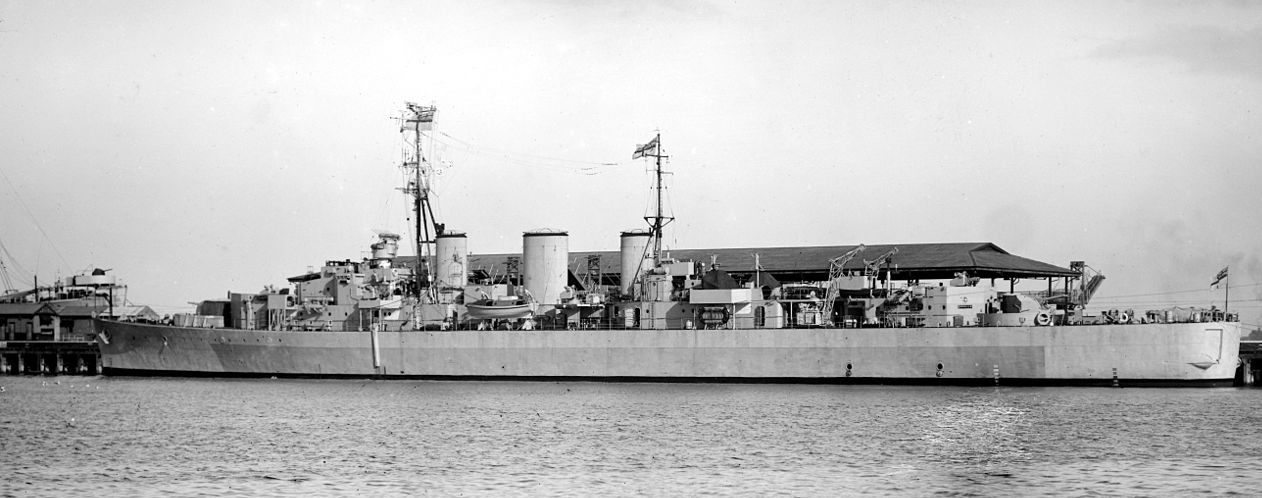
Another pair were laid down in 1938 and 1940, while a further four had to be added to the building programs in 1942 (2 in UK, 2 in Australis) to make up for war losses to the class.
HMS Abdiel (ML-1939)
Back to Commonwealth Ships List
The Abdiel class minelayers marked a departure in doctrine for the Royal
Navy. Previously all offensive minelaying had to be done by the destroyers and
cruisers fitted for the task. It was determined that because the speed of
aircraft had increased so much since WW1 (from 120mph to 300mph+) that the
destroyers and cruisers acting at 30-35 knots were no longer fast enough to get
to the laying point and home again in darkness. Enemy aircraft would be able to
spot them and deduce a minelaying operation had been undertaken and would then
be on the lookout for a new field. To get there and back in darkness required
ships of over 40 knots. To this end a pair of minelaying 'cruisers' (they were
more big destroyers) were laid down in 1936 and completed in 1939.

Another pair were laid down in 1938 and 1940, while a further four
had to be added to the building programs in 1942 (2 in UK, 2 in Australis) to make up for war losses to the class.

Fastest ships in the fleet, no other Royal Navy ships bettered 40 knots. The various shortages that occurred late 1940-41 came about from all the various shipyards, factories etc all clamouring for iron and steel to meet the new 2 shift 16 hour days that became the norm on the outbreak of war. It is the production of steel in all its infinite varieties that bottlenecks production in the United Kingdoms. Most of the raw materials have to be brought in from overseas then put through the manufacturing process. Gearing up for war production does not happen overnight and priorities are set for what is available. If your building project (ship, car, plane, tank, AA gun, etc) does not have a priority then you have to use whatever is available. This was done in the production of many ship types where the specified armaments were not available and substitutes were found and fitted to get the ships to sea. This happened to the Argonaut sub-class that had to be fitted with twin 4" in place of the twin 4.5". The twin 4.5" open mount weapon system was designed for this class to save weight when compared to the 4.5" twin turret and because using turrets with their intrusion into the hull created problems with the layout of the mine deck.
| Displacement | 3050 tons std, 4200 tons full load. | |
| Length | 436 ft | |
| Breadth | 42 ft | |
| Draught | 12 ft | |
| Machinery | 2 shaft Steam turbines, 90,000shp | |
| Speed | 42 knots | |
| Range | 6000 miles at 15 knots, 1800 @ 35 knots | |
| Armament | HMS Spartiate as completed 1939 8 x 4.5" (4x2) 8 x 2pd (2x4) 12 x 20mm (4x2, 4x1) |
HMS Argonaut as completed 1940 8 x 4" (4x2) 8 x 2 pd (2x4) 8 x 20mm (4x2) |
| Mines | 160 large 200 small | |
| Complement | 250 | |
| Notes | ||
The Abdiel class minelayers for my AU purposes, spawned quite a few differing
layouts and armaments. I even drew the real ship.

Above: original drawing which was okay, but needed a bit more.

Above and below: another two versions of the ones above. Differences in armament
and hull details.

Below: the real Abdiel class ship HMS Ariadne from the batch II vessels.
Her first duty was to lay mines off the coast of Norway. She was also one of the ships taking part in Operation Stonewall. She then left Home waters in January 1944 to join the United States Seventh Fleet in the Pacific Ocean theatre of war. In June 1944 she laid 146 mines off the northern coast of New Guinea, and when landings were made in the Mapia Group of islands in November 1944, Ariadne was used to carry US Army soldiers. During her period of active service she laid 1,352 mines.
After the end of the war,
Ariadne was used to repatriate British prisoners of war from Japan and as a
mailship due to her speed. She was paid off into the Reserve Fleet at Sheerness,
and did not see service again, apart from a short trial after a refit in the
1950s. This involved the replacement of her light anti-aircraft guns with more
modern weapons. She was finally sold to W.H. Arnott Young for scrapping and
arrived at Dalmuir in February 1965. She was then scrapped at Dalmuir and Troon
in June 1965.
